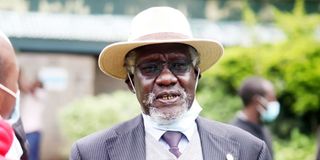BBI lacks population-surface area balance

Kenya National Council of Elders deputy chairman Major (Rtd) John Seii in Nairobi on Friday. He claimed the report was doctored.
What you need to know:
- The additional 70 sets in the National Assembly and whether or not to send more women to the Senate and do away with Women Reps.
When Ian MacLeod convened the first constitutional conference in 1960 to chart the way for Kenya’s independence, he was met with opposition, notably from the youthful Taita Towett, then a youthful representative from the Kalenjin community.
This forced a second and third conferences to be held in 1962 and 1963, respectively.
Then, as now, the most contentious issue was representation in Parliament — the National Assembly and the Senate. The delegates could not even agree on the cut-off age of a becoming a senator, with some proposing that only those aged 50 and above hold the post.
This age group was deemed to be more experienced politically. No wonder, in the 2013 General Election the Senate was termed as “nyumba ya wazee” (home for the aged) and did not attract youthful contestants like in 2017.
After the early 1960s, the next constitution-making process would come decades later, culminating in the promulgation of the current Constitution in 2010.
We are now in another constitutional moment, courtesy of the Building Bridges Initiative (BBI). Once again, mistrust has crept in, watering down the gains of the process.
Major (Rtd) John Seii, a prominent member of the BBI Task Force, like Dr Toweet before him, will not agree with Paul Mwangi, the modern-day Ian McLeod.
The most contentious issue, once again, is on parliamentary representation: The additional 70 sets in the National Assembly and whether or not to send more women to the Senate and do away with Women Reps.
In the proposed amendments, some counties have been shortchanged in terms of representation. For example, “Nairobi’s bedroom”, Kiambu, with a geographical size of 2,449 square kilometres, will have six more constituencies to make a new total of 18. That means populous hamlets like Gachie, Muchatha, Banana Hills and Ndenderu will have their own MPs.
Not so in Nyandarua, however. With a larger geographical size of 3,108 square kilometres, the county, which feeds Nairobi and its environs and also neighbours Kiambu, has five constituencies. In the proposed amendments, it gets zero additional MPs.
The capital city would get an additional constituencies, to be represented in the National Assembly by a whopping 33 MPs.
The former greater Embakasi Constituency in Nairobi, with a geographical area of 208 square kilometres, has five constituencies, same as Nyandarua. These are likely to give birth to more constituencies and we are likely to have Dandora, Kayole and Soweto MPs in Parliament.
With these contentious flaws, BBI is likely to flop like McLeod’s first conference in Lancaster, UK.
Ngure Kamau, Nyandarua




